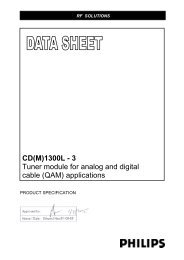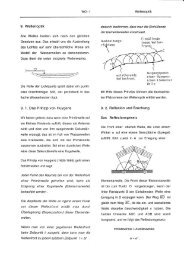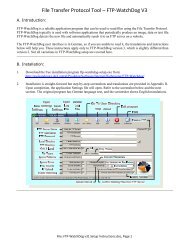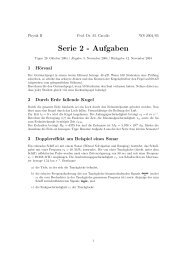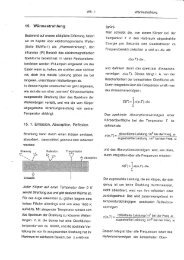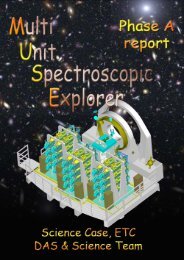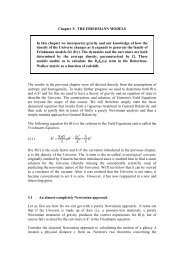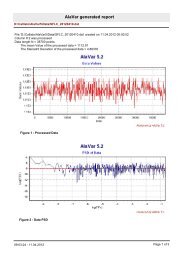L-Band (Neutral Hydrogen, 21 cm / 1420 MHz)
L-Band (Neutral Hydrogen, 21 cm / 1420 MHz)
L-Band (Neutral Hydrogen, 21 cm / 1420 MHz)
You also want an ePaper? Increase the reach of your titles
YUMPU automatically turns print PDFs into web optimized ePapers that Google loves.
L-<strong>Band</strong> (<strong>Neutral</strong> <strong>Hydrogen</strong>, <strong>21</strong> <strong>cm</strong> / <strong>1420</strong> <strong>MHz</strong>)Probability of spin - transition 2.9*10 -15 / sec= 1 transition in 10 million yearsPredicted: Dr. Hendrik van de Hulst 1944 → <strong>1420</strong>.4058 <strong>MHz</strong>Discovered: Even & Purcell 1951
Microwave telescopeMapping 3 <strong>cm</strong>MemorySticketc.MouseHeterodyne<strong>21</strong><strong>cm</strong> (1.42 GHz) ≈152 <strong>MHz</strong> Receiver 10.7 <strong>MHz</strong>BPF H2-ConverterAR 5000 BPF FFTLOCoaxialswitchPSU12 KHzresolutionCOMRS-232USB 1USB 2NotebookUSB 44-Port USB HubUSB 3Telescope 1mPSUPSUØ1m12VPSUAntenna control COM RS-23<strong>21</strong>2VFFT:MonitorIFSMAVGAMouseFFTPS/2RS-232 ‘Antos’USBKeyboard
Qualification measurementsTransit of a source through a telescope beam (5m dish) in fixed position- Sources: sun, moon, sources of neutral hydrogen- Experiments:- check pointing of telescope at single frequency- measure angular resolution in declination and/or hour angle- side lobe attenuation, beam angle, directivity, gain, …- source temperature and/or source flux etc….
<strong>21</strong> <strong>cm</strong> - measurements326Vergleich zwischen on- und off-Source83163062962861418 1419 <strong>1420</strong> 14<strong>21</strong> 1422Frequenz [<strong>MHz</strong>]0.0510.0310.011-0.009-0.029on Source (digit)(S-N)/Noff source (digit)-0.0491418 1419 <strong>1420</strong> 14<strong>21</strong> 1422Frequenz [<strong>MHz</strong>]Temperatur [K]76543<strong>21</strong>0-200 -100 0 100 200 300Geschwindigkeit [km/s]Example:Measurement of neutral hydrogen at <strong>1420</strong> <strong>MHz</strong> with 1 m radio telescope at Diavolezza.
Ku-<strong>Band</strong> Observations11.7 +- 1 GHz, λ ~ 2.5 <strong>cm</strong>Sources: sun, moon, military-, scientific- or commercial satellites
Ku-<strong>Band</strong> ObservationsExperiments:- measure temperatures of sun and moon- create raster fly maps in RA/DEC or AZ/EL or GL/GB- check telescope pointing, measure angular resolution, beam pattern- check antenna gain, effective area, system temperature, etc.
Interferometry:WHY:• to reach high angular resolution,esp. at long wavelengths (radio)HOW:• based on interference ofelectro-magnetic wavesVery Large Array, New MexicoOUR EQUIPMENT:• 2-element adding interferometer +CALLISTO spectrometer
Possible projects:1 – Diameter of the Sun (angular size) in radio wavelengths(DAY)2 – Transit of circumpolar satellites(DAY/NIGHT)(3) – Detection of strong radio sources in thesky, e.g. Cassiopea A and Cygnus A(NIGHT)
Motivation:Atacama Large Millimeter Array, Chile,coming soon..1 - Opportunity to deal with one of the mostimportant modern observational techniques..2 - ..and learn-by-doing its principles and capabilities3 - Weather- and time-independent observations(sunny/cloudy, day/night)(4) - ..and eventually to stay indoor while outside is -20




